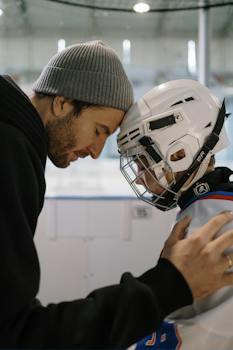

-
Table of Contents
Unveiling the untamed spirit of hockey.
Introduction
Hockey, a fast-paced and physically demanding sport, has long been a source of excitement and entertainment for fans worldwide. However, beyond the exhilarating gameplay and passionate fan base, there exists a controversial side to hockey that often sparks heated debates. From aggressive on-ice behavior and dangerous hits to the prevalence of fighting, exploring the controversial aspects of hockey sheds light on the ethical and safety concerns surrounding the sport. In this article, we will delve into these contentious issues, examining the arguments from both sides and seeking a deeper understanding of the controversies that surround the game of hockey.
The Impact of Fighting in Hockey: Analyzing the Pros and Cons
Hockey is a sport that has always been associated with physicality and aggression. From bone-crushing body checks to intense fights, these elements have become an integral part of the game. However, the presence of fighting in hockey has sparked a heated debate among fans, players, and officials. While some argue that fighting adds excitement and intensity to the game, others believe that it promotes violence and poses serious risks to players' safety.
One of the main arguments in favor of fighting in hockey is that it serves as a form of self-policing. In a fast-paced and physical game like hockey, players often find themselves in heated confrontations. By allowing fights to occur, players can settle their disputes on the ice rather than resorting to more dangerous forms of retaliation. Proponents of fighting argue that it helps maintain order and prevents players from taking matters into their own hands, potentially leading to more serious injuries.
Another argument in favor of fighting is that it energizes the crowd and adds excitement to the game. Hockey fans have long been drawn to the sport's physicality, and fights have become a spectacle that can ignite the crowd and create a charged atmosphere. Supporters of fighting claim that it keeps fans engaged and entertained, enhancing the overall experience of watching a hockey game.
However, opponents of fighting in hockey argue that it promotes violence and sends the wrong message, especially to young fans. They believe that allowing fights to occur normalizes aggressive behavior and can lead to an increase in on-ice violence. Critics argue that hockey should be a sport focused on skill and strategy, rather than physical altercations.
Moreover, the safety of players is a major concern when it comes to fighting in hockey. While players are required to wear protective gear, fights can still result in serious injuries. Punches to the head can cause concussions, and players have suffered long-term consequences from repeated blows. Critics argue that the risks outweigh any potential benefits and that the league should prioritize player safety above all else.
In recent years, the NHL has taken steps to reduce fighting in the game. Rule changes and stricter penalties have been implemented to discourage players from engaging in fights. The league has also focused on promoting skill and speed, shifting the emphasis away from physicality. These changes have been met with mixed reactions, with some praising the efforts to make the game safer, while others argue that fighting is an essential part of hockey's identity.
In conclusion, the presence of fighting in hockey remains a controversial topic. While some argue that it serves as a form of self-policing and adds excitement to the game, others believe that it promotes violence and poses serious risks to players' safety. The NHL's efforts to reduce fighting have sparked a debate about the future of the sport and what it means to be a hockey player. Ultimately, the decision on whether fighting should be allowed in hockey will continue to be a contentious issue that divides fans, players, and officials alike.
Examining the Role of Violence in Hockey: Is it Necessary?

Exploring the Controversial Side of Hockey
Hockey is a sport that has captivated fans around the world for decades. Known for its fast-paced action and physicality, hockey has also been the subject of controversy due to its violent nature. In this article, we will examine the role of violence in hockey and question whether it is necessary for the sport.
Violence has long been a part of hockey, with fights and hard hits being a common occurrence on the ice. Some argue that this aggression is an integral part of the game, adding excitement and intensity. They believe that the physicality of hockey sets it apart from other sports and makes it unique. However, others argue that violence has no place in a sport that should be focused on skill and strategy.
One argument in favor of violence in hockey is that it serves as a form of self-policing. In a fast-paced game like hockey, where players are constantly in close proximity to each other, tensions can run high. By allowing players to engage in fights, it is believed that they can release their frustrations and prevent more dangerous acts of aggression. This argument suggests that violence is a necessary evil that helps maintain order on the ice.
On the other hand, opponents of violence in hockey argue that it sets a bad example for young fans and promotes a culture of aggression. They believe that allowing fights and hard hits normalizes violence and can lead to dangerous behavior both on and off the ice. Critics argue that hockey should be a sport that promotes fair play and sportsmanship, rather than encouraging players to engage in physical altercations.
Another point of contention is the issue of player safety. With the increasing size and speed of players, the impact of hits and fights has become more dangerous. Concussions and other serious injuries have become a major concern in hockey, leading to calls for stricter rules and penalties. Critics argue that the violent nature of the sport puts players at unnecessary risk and that steps should be taken to prioritize their safety.
In recent years, the NHL has taken steps to address the issue of violence in hockey. Rule changes have been implemented to penalize dangerous hits and fights, and players are now subject to suspensions and fines for their actions. These changes have been met with mixed reactions, with some praising the league for taking a stand against violence, while others argue that it has taken away from the essence of the game.
In conclusion, the role of violence in hockey is a controversial topic that divides fans and experts alike. While some argue that it is an integral part of the sport, others believe that it promotes a culture of aggression and puts players at unnecessary risk. The NHL's efforts to address the issue have sparked debate, with opinions varying on whether these changes are positive or detrimental to the game. Ultimately, the future of violence in hockey remains uncertain, and it will continue to be a topic of discussion for years to come.
The Dark Side of Hockey: Investigating the Effects of Concussions on Players
Hockey is a sport that has captivated fans around the world for decades. With its fast-paced action and physicality, it is no wonder that hockey has gained a reputation for being a tough and intense game. However, behind the excitement and glory of the sport lies a dark side that is often overlooked – the issue of concussions and their long-term effects on players.
Concussions have become a hot topic in the world of sports, and hockey is no exception. The high-speed collisions and hard hits that are a part of the game can lead to serious head injuries, with players often suffering multiple concussions throughout their careers. These injuries can have devastating consequences, both in the short term and in the long run.
In the short term, concussions can cause a range of symptoms, including headaches, dizziness, and confusion. Players may also experience sensitivity to light and noise, as well as difficulty concentrating and remembering things. These symptoms can be debilitating, making it difficult for players to perform at their best on the ice.
But it is the long-term effects of concussions that are truly concerning. Research has shown that repeated head injuries can lead to a condition known as chronic traumatic encephalopathy (CTE). CTE is a degenerative brain disease that is characterized by the buildup of an abnormal protein called tau in the brain. This protein can cause a range of symptoms, including memory loss, depression, and aggression. In some cases, CTE can even lead to dementia.
The link between hockey and CTE has been the subject of much debate and controversy. While some argue that the sport is inherently dangerous and that more needs to be done to protect players, others believe that the risks are overstated and that the benefits of playing hockey outweigh the potential dangers. Regardless of where one stands on the issue, it is clear that concussions are a serious concern in the world of hockey.
In recent years, the NHL has taken steps to address the issue of concussions. The league has implemented stricter rules regarding hits to the head and has increased penalties for players who engage in dangerous play. Additionally, the NHL has invested in research and education programs aimed at raising awareness about concussions and promoting player safety.
However, there is still much work to be done. Many argue that the NHL needs to do more to protect its players, such as implementing stricter protocols for diagnosing and treating concussions. Others believe that the culture of the sport needs to change, with players, coaches, and fans alike recognizing the importance of player safety and taking steps to reduce the risk of head injuries.
In conclusion, while hockey may be a thrilling and beloved sport, it is important to acknowledge the dark side that comes with it. The issue of concussions and their long-term effects on players is a serious concern that cannot be ignored. As the debate continues, it is crucial that steps are taken to protect the health and well-being of hockey players at all levels of the game. Only then can we truly enjoy the sport while ensuring the safety of those who play it.
Q&A
1. What are some controversial aspects of hockey?
Some controversial aspects of hockey include fighting, head injuries, and aggressive play.
2. Why is fighting controversial in hockey?
Fighting in hockey is controversial because it promotes violence and can lead to serious injuries.
3. How do head injuries contribute to the controversy surrounding hockey?
Head injuries, such as concussions, are a major concern in hockey due to their long-term effects on players' health and well-being. This has sparked debates about player safety and the need for stricter rules and regulations.
Conclusion
In conclusion, exploring the controversial side of hockey reveals the existence of various contentious issues within the sport. These controversies range from physical violence and dangerous plays to issues surrounding player safety and the enforcement of rules. While hockey is a beloved sport by many, it is important to acknowledge and address these controversies in order to ensure the safety and integrity of the game.












